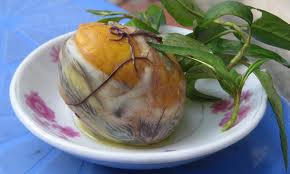Western
culture considers that eating a dog is not good, but there will be no
problem with other sorts of animals, as long as they are not called
pets. However, for the vast majority of people on Earth, cultural values
are very different. Some strange foods are considered a delicacy in
some Asian cultures including China, Korea, Philippines, Vietnam, Laos,
Cambodia, Thailand and Myanmar. Indeed, these food are very tasty and
protein rich. May be you should try them some day if you are not
vegetarian.
Not for everyone, as you might not be able to get the image of your beloved ‘fluffy’ out of your head, but travellers we met who tried it absolutely loved it.
Some kinds of snake dishes
Snakes are a common novelty and relished food. You can drink the wine as well as eat the flesh on several occasions. When I visit one of my Vietnamese friends, he caught a cobra outside his front door and shared it with me on evening. Actually, there is very little meat on a cobra, so the skin is eaten as well. In the village of Le Mat, which famous for its snake restaurants, I tried snake meat in a number of ways, including in soup (both the taste and texture was like crab meat) and spring rolls (tastes like chicken). Furthermore, snake blood is supposed to be healthy with many benefits as well as a natural form of Viagra. So what is its taste like? I was surprised that tasting a fried meat actually a bit like custard. There is no fat and extremely lean and tender. After trying snake, you will surely be back for more.
I watched my friends eating trung vit lon for many months before trying it myself. These fertilized duck eggs are allowed to partially develop and then, they are hard-boiled. Crack the top off, suck out the juice and then spoon out the colorful morsels with pinches of pickled carrots, garlic, radish, turnip, some mint leaves, and a dash of salt and pepper.
Although many or all of the above meats may not be your cup of tea, you must respect the culture of food in Vietnam however how far removed from your own food culture. It is important to not judge people on what they eat as it is normal for them and a way of life.
read more...
Dog
This is regarded as special meat and is usually consumed on special occasions or on the second half of the lunar month. There are a number of specialized restaurants in Nhat Tan street Hanoi that cater in all forms of Dog cuisine. Dog is regarded as a delicacy and is know for it warming feeling in the chest after eating.Not for everyone, as you might not be able to get the image of your beloved ‘fluffy’ out of your head, but travellers we met who tried it absolutely loved it.
Some kinds of snake dishes
Snakes are a common novelty and relished food. You can drink the wine as well as eat the flesh on several occasions. When I visit one of my Vietnamese friends, he caught a cobra outside his front door and shared it with me on evening. Actually, there is very little meat on a cobra, so the skin is eaten as well. In the village of Le Mat, which famous for its snake restaurants, I tried snake meat in a number of ways, including in soup (both the taste and texture was like crab meat) and spring rolls (tastes like chicken). Furthermore, snake blood is supposed to be healthy with many benefits as well as a natural form of Viagra. So what is its taste like? I was surprised that tasting a fried meat actually a bit like custard. There is no fat and extremely lean and tender. After trying snake, you will surely be back for more.
Lizards and frogs (best grilled) are standard fare in Phan Thiet Is delicious and similar in flavour to chicken. Frogs legs are eaten the world round. And there are a number of different ways of preparation throughout the world. Simply floured and fried in butter and onions with a side of chilli sauce was the best we had.
Although many or all of the above meats may not be your cup of tea, you must respect the culture of food in Vietnam however how far removed from your own food culture. It is important to not judge people on what they eat as it is normal for them and a way of life.I watched my friends eating trung vit lon for many months before trying it myself. These fertilized duck eggs are allowed to partially develop and then, they are hard-boiled. Crack the top off, suck out the juice and then spoon out the colorful morsels with pinches of pickled carrots, garlic, radish, turnip, some mint leaves, and a dash of salt and pepper.
Although many or all of the above meats may not be your cup of tea, you must respect the culture of food in Vietnam however how far removed from your own food culture. It is important to not judge people on what they eat as it is normal for them and a way of life.





